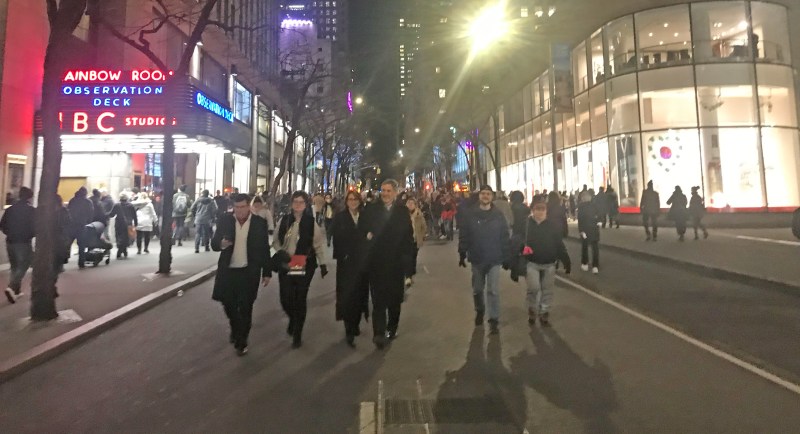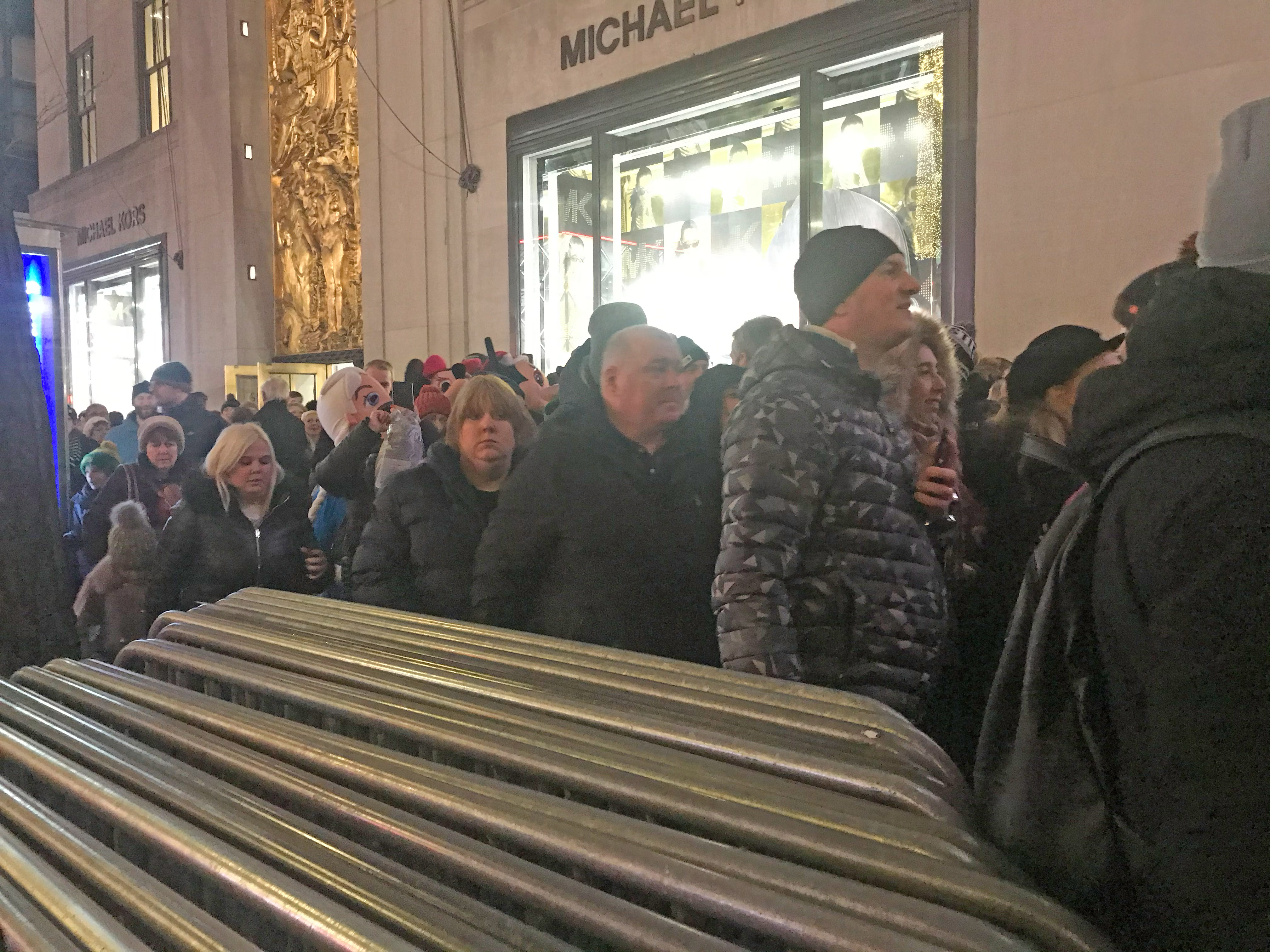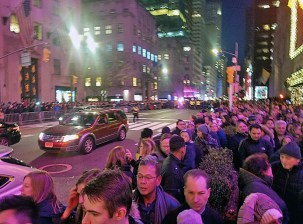Eyes on the Street: Miracle on Fifth Avenue Near Rockefeller Center

Mayor de Blasio’s bold plan to take lanes away from drivers and give them to pedestrians around Rockefeller Center is working — but only on the side streets that are actually closed to cars entirely.
The city kicked off the first-ever pedestrianization of the area on the Friday after Thanksgiving, by nixing two lanes of car and bus traffic on Fifth and Sixth Avenues, and closing W. 49th and 50th streets between the two avenues to car drivers.
The long-awaited changes, which will continue through Jan. 6, were lauded by safe-street advocates and local pols who pushed for the mayor to finally prioritize pedestrians over motor vehicles on the seasonally super-crowded streets.
“Rockefeller Center is the most heavily visited site in all the five boroughs during the holiday season. While this is a good problem to have, it does require increased and proactive planning for the crush of pedestrians that descend upon the space,” said Manhattan Borough President Gale Brewer after the plans were announced on Nov. 22. “I am pleased that the mayor and the DOT have headed mine and Council Member Powers’s calls to increase pedestrian space in this area. It is my hope that this likely-successful pilot during the holiday season can lead us to a year-round pedestrianization of the space.”
But how is it all working, really? Streetsblog checked out the area the night after Hizzoner ceremoniously lit the Christmas tree in front of 30 Rock — an annual celebration that attracts people from all over the world that night and throughout the holiday season. Here’s what we thought:
On pedestrianized W. 49th and W. 50th Streets
Thousands of revelers packed W. 50th Street on Thursday night to see the holiday displays in retailers’ windows and, of course, gaze at the massive tree — sure, it was spectacular and twinkling, but the real beauty was the two car-free streets.
For the next month, the Department of Transportation and Police Department will close the side streets between Fifth and Sixth Avenues entirely to cars between 2 p.m. and midnight, Monday through Thursday, 1 p.m. and midnight on Fridays, and 10 a.m. and midnight on weekends.
So by Thursday evening at about 6:30 pm, families were joyously able to walk hand in hand, push kids in strollers, and not have to worry about moving out of the way of cars while gazing up at the festively decorated pine.
One woman visiting from Georgia, who had also visited the Big Apple a few years ago during peak congestion season in December, said this time she felt she had much more room to breathe and move around safely.
“This is a lot easier,” said Donna Garrard, as she gazed up at the tree from W. 50th Street.
Garrard’s friend, who had never before been to the area, couldn’t even fathom what it would look like if cars were still allowed to drive down the side streets.
“I think it would be far worse, we’d all be on the sidewalk. I can’t imagine if cars were running through here, I don’t know how that would work,” said Andrea Towns.
Even vendors — whom the mayor previously blamed for the chaos, though they are clearly a tangental issue — were not allowed to enter the pedestrian-only side streets.
At one point, this reporter spotted a cop parked in his squad car on 50th Street get out and tell a street vendor that he could not walk with his cart down 50th Street.

The officer from the Seventh Precinct told Streetsblog that the area is much more tame than in years past and safer to navigate.
“For pedestrian safety, it’s a lot better,” said Office Beltran, who declined to give his first name. “Less hectic.”
On Fifth and Sixth avenues
But as expected, not everything was perfect.
In addition to closing the two side streets, the city also took away two lanes of car and bus traffic on both of the seasonally super-crowded avenues — an expansion upon an initial plan that was hastily scrubbed by de Blasio as “premature.”
Each night until Jan. 6, the city will deploy movable barriers after 5 p.m. on weekdays and around noon on weekends to carve pedestrian space out of a lane of car and bus traffic on each side of Fifth Avenue between 48th and 52nd streets. The barriers will remain in place until midnight. The city said it would similarly place barriers, as needed, on each side of Sixth Avenue for the same four blocks — an improvement on the original proposal, which only included Fifth Avenue.
But on busy Fifth Avenue — where hundreds of people stood looking up at the buildings’ light shows set to popular musicals like Frozen — the extra barriers waiting to be placed as needed to help mitigate the crowd situation only seemed to hinder movement more than help it.

As fellow transit scribe Vin Barone noted on Dec. 3, the metal gates were positioned to only allow certain points of entry on the side streets.
Lots of room on these crosstown streets but the barricades are positioned to only allow certain points of entry. pic.twitter.com/jwxEbO87x4
— Vincent Barone (@vinbarone) December 3, 2019
By Thursday night, those were moved — to Fifth Avenue, where people clearly didn’t know they could step off the sidewalk and onto the roadway-turned-temporary walkway.

Hordes of people were still squished into the narrow sidewalk along Fifth avenue, while the temporary sidewalk remained almost empty at times. And on the corner of 50th Street and Fifth avenue, the barriers themselves took up a significant amount of space.


Why did we need this?
This year’s first-even pedestrianization comes after years of failure to prioritize pedestrians. Last year, Hizzoner and then-NYPD Commissioner James O’Neill admitted that they didn’t do enough to ease the dangerous conditions for pedestrians in the area. It even got so bad around Times Square — where the sidewalks were filled to the brim with pedestrians, spilling out onto the still-active streets — that additional cops were requested to help control the crowds.
The only thing that could have made it better is if both Fifth and Sixth Avenues were also closed entirely to private cars — next year, right Mr. Mayor?

